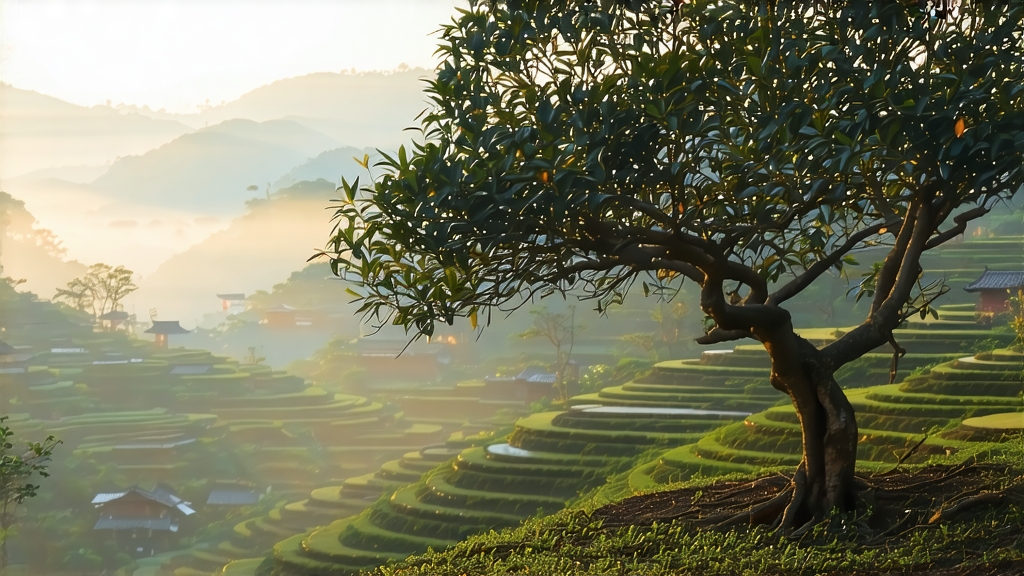
If green tea is the fresh-faced youth of Chinese tea and pu-erh the wise elder, then Phoenix Dancong (Fenghuang Dancong) is the eloquent poet—fragrant, layered, and endlessly articulate. Grown on the steep, granite cliffs of Fenghuang Mountain in northern Guangdong, this oolong sings with floral, fruity, and honeyed notes that change with every steeping like verses in an unfolding epic. To understand Dancong is to eavesdrop on eight centuries of Song dynasty legacy, Hakka craftsmanship, and the whisper of mineral-rich clouds that coil around Wudong peak at dawn.
A SINGLE NAME, A THOUSAND AROMAS
Although “Dancong” literally means “single bush,” the term today refers to a family of clonal tea trees propagated from centuries-old mother plants. Each tree adapted to its micro-terroir, absorbing the scent of surrounding wildflowers, fruit trees, and even the resinous bark of neighboring pines. Local farmers, noticing how individual bushes produced liquor with distinct fragrances, began naming them after those aromas: gardenia (Huangzhi Xiang), almond (Xingren Xiang), ginger flower (Jianghua Xiang), honeysuckle (Yinhua Xiang), and the legendary “Duck Shit Aroma” (Yashi Xiang)—a name coined to deter thieves yet now coveted by connoisseurs. Over 80 aromatic profiles have been catalogued, making Phoenix Dancong perhaps the world’s most perfumed tea.
SONG ROOTS & HAKKA HEART
The story begins during the Southern Song (1127–1279) when imperial retinues fled northward and settled among the granite spires of Fenghuang. They carried tea seeds and courtly rituals, planting the first bushes on ledges so narrow that even goats hesitate. The indigenous She minority and later Hakka migrants mastered the art of terrace-less cultivation, training each trunk into umbrella-shaped canopies that resist typhoon winds. By the Ming, these “Song cultivars” were tribute tea; by the Qing, they traveled the maritime tea routes to Southeast Asia, carried in the holds of clipper ships alongside porcelain and silk. Today, venerable trees aged 300–600 years still yield small harvests auctioned for more than their weight in silver, their gnarled bark inscribed with the calligraphy of time.
FROM LEAF TO LINGUISTICS
Modern Dancong is harvested in late April, after the spring rains have swollen the leaves with mountain mist. Only the top three leaves and a half-open bud are plucked between 9 a.m. and 2 p.m., when dew has evaporated but before the afternoon sun wilts the aromatics. The craft that follows is a choreography of withering, bruising, oxidation, and fire that would make a vintner blush.
- Sun-withering: Leaves are spread on bamboo mats under a gentle morning sun for 15–30 minutes, softening cell walls and initiating enzymatic change.
- Indoor withering & shaking: Moved onto raised screens in humidified rooms, the leaves are rhythmically tossed every hour through the night. This “green work” ruptures edges, allowing polyphenols to meet oxygen and forge the tea’s signature peach, orchid, or lychee notes.
- Oxidation: Unlike Tie Guan Yin, which is only 20–30 % oxidized, Dancong is pushed to 40–50 %, threading the needle between green brightness and black depth.
- Kill-green: A 280 °C wok roast lasting 3–5 minutes halts oxidation, locking in aromatics while adding a whisper of toasted sesame.
- Rolling: The hot leaves are wrapped in cloth bundles and rolled underfoot, twisting them into dark, glossy strips that resemble iron wire.
- Charcoal roasting: The soul of Dancong is born here. Using 20-year-old lychee wood, artisans maintain a low 60–70 °C ember for 6–10 hours, repeating the roast up to three times over two months. Between firings the tea “rests,” allowing moisture to migrate outward so the heat penetrates evenly. The result is a liquor that glows like topaz and tastes of caramelized peach, frankincense, and the flinty breath of granite.
THE ART OF SEVEN INFUSIONS
To brew Phoenix Dancong is to conduct a slow crescendo. A 120 ml gaiwan or small Yix